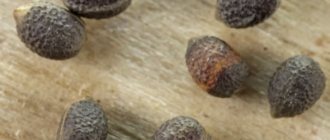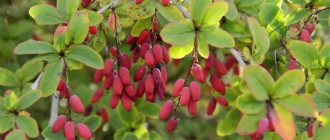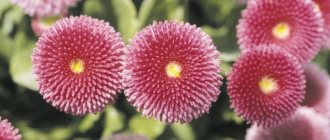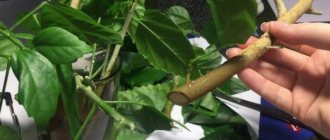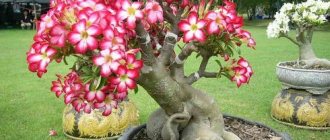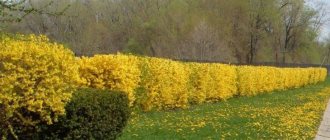Features of cultivation
Although the primrose plant is quite unpretentious, there are some nuances and features in its cultivation.
By March 8th in the greenhouse
For cultivation in greenhouses, cuttings of mother bushes or two-year-old seedlings are used. They are dug out of the ground before the first frost and, together with a lump of earth, planted in special boxes or pots. They are then stored in a cool place, such as a leafy greenhouse or basement.
During this period of the year, caring for primroses consists of ensuring a reduced temperature of 5 - 8 degrees. If the flowers are kept warm and there is good lighting, they will begin to quickly grow green mass. This has a negative effect on the formation of flower buds. These plants will bloom sparingly and later than the prescribed time. They should not be watered at this time of year.
In the last winter month, the primrose is moved to a place with good lighting and elevated temperatures, approximately 18 degrees. At this time, watering for flowers is gradually restored. If the plants were given proper care and the correct temperature was provided at 12 - 15 degrees, then they will bloom profusely and for a long time.
In the open ground
As many gardeners note, primrose is completely unpretentious in the growing process. It is enough just to feed it with fertilizers on time and follow the watering regime and rules.
Fertilizers and humus
- Immediately after the snow melts, complex mineral fertilizer, which includes nitrogen, phosphorus and potassium, is applied to the cleaned and loosened soil at a dosage of 10-20 grams per 1 sq.m. After two weeks, superphosphate is added in the same volume to stimulate flowering.
- 12 - 15 days after the flowers appear, feed with mullein solution to stimulate the formation of the next flower buds. Part fertilizer to 10 parts water, half a liter per plant.
- Around mid-August, to increase cold resistance, they are fed with phosphorus and potassium fertilizers, 15 - 20 grams per 10 liters of water.
Leaf humus is used as organic fertilizer. They do it according to this scheme:
- In late autumn, fallen leaves are collected and placed in opaque, preferably black, plastic bags, which are left for 9 to 12 months in an unheated room.
- After this time, the leaves are crushed and applied to the soil.
If it is not possible to chop the leaves, then the time they remain in the bags increases until they self-disintegrate into small pieces.
Hydration
For normal development, constantly moist soil is required. In spring, watering is done approximately once a week. In hotter periods, watering is carried out once every three days, using 3 liters of water per 1 sq.m. If the summer is too dry, watering is done every day.
Japanese primrose: description, care, reproduction and pest control
Japanese primrose belongs to the category of perennial plants that prefers light soils. This plant is characterized by ease of care and quite attractive appearance, which arouses the interest of many gardeners and landscape designers.
Description of the plant
Japanese primrose is characterized by the presence of a very developed basal foliage rosette. The foliage of this plant is bright green in color and has jagged ends. Stems with flowers rise significantly above the rosette of leaves. The height of the stem can be from 20 to 30 centimeters.
This plant is characterized by the presence of strong peduncles and large inflorescences.
Japanese primrose flowers are arranged evenly on the flower stalk. The diameter of the flower is about 2 centimeters.
The flowers have a unique arrangement and can form about 5-6 tiers on a peduncle. This plant begins to bloom in June or July. The flowering period of primrose is about 30 days.
Features of care
Japanese primrose loves the sun very much, so it must be planted in well-lit places. This plant loves moisture very much, so it needs regular watering. It is necessary to monitor soil moisture especially carefully in the spring. This is explained by the fact that at the moment the primrose is gaining strength, which it will need for further flowering.
Japanese primrose requires regular feeding:
This plant needs to be fed 4 times per season.
- The first fertilizing should be done immediately after the snow melts. To perform this action, mineral fertilizers are used.
- A few weeks after the first fertilizing, superphosphate is added to the soil.
- The third feeding is done at the end of July, which allows the plant to lay new buds. To perform this action, organic fertilizers are used, which include superphosphate. The fourth feeding is the first step towards preparing for wintering. It is produced at the end of August using superphosphate.
Japanese primrose loves loose soil, which necessitates regular weeding. It is also necessary to add a thin layer of new soil under the primrose every year and evenly level it. This plant also requires periodic planting.
To do this, you need to dig up the bushes every 3-4 years and divide them into several new ones.
In order to protect the plant from various negative influences, the leaves are left on it until late autumn. Despite the fact that Japanese primrose is a fairly winter-hardy plant, it must be covered with a thin layer of leaves for the winter.
Primrose care involves doing the following:
- Correct selection of place and soil for planting.
- Regular watering.
- Weeding.
- Fertilizer application.
- Proper preparation for wintering.
Carrying out all these actions will help not only maintain the viability of the Japanese primrose, but also significantly improve its appearance and fruiting.
Reproduction of Japanese primrose
Japanese primrose can reproduce in three ways:
- Using seeds.
- Leaf cutting method.
- Method of root cuttings.
- Dividing bushes.
The easiest way to propagate Japanese primrose is to use seeds. To do this, you need to collect the seeds and plant them in the ground the same year, in the fall. Seeds can be planted both in open ground and in a greenhouse.
If you want to propagate Japanese primrose using seedlings, then:
- Planting seeds in a room should be done in February or March.
- For this purpose, special boxes are used, which are filled with leaf humus, sand and weathered peat.
- In order for the seeds to produce good similarity, they must be sprinkled with a very thin layer of soil during planting.
- Boxes with primrose must be covered with polyethylene or glass.
- This will significantly speed up the growth of this plant.
- After the primrose has risen, it is gradually accustomed to fresh air by opening the film or glass.
- The opening period of the film must be gradually increased.
When the seeds first sprout, it is very important not to over-moisten the soil. Otherwise, the Japanese primrose may die. Seedlings can bloom only in the second year after planting.
Very often, the method of leaf cuttings is used to propagate Japanese primrose:
- This procedure is carried out in late spring. Primrose leaves should not be cut, but plucked off.
- This will significantly increase the plant's survival rate.
- The leaves can be placed in a vessel with water and wait until they take root, and then plant them in the ground.
- It is also possible to plant the leaves directly into the ground.
- In this case, they need to be provided with moderate and systematic watering.
The plant is propagated by root cuttings in the autumn.
To do this, you need to select sufficiently strong roots and cut them out from the root system of the primrose bush. The roots are placed immediately into the soil. To perform this action, you must use greenhouses. In order for the roots to take root faster and sprout, vertical cuts are made on them.
One of the easiest ways to propagate Japanese primrose is by dividing the bush:
- This procedure can be performed both in autumn and spring.
- To do this, you need to dig up a bush and divide it into several parts with your bare hands.
- In this case, you should not use any cutting objects, which will increase the survival rate of the bush.
- Newly formed primrose bushes are planted in the ground and provided with regular and moderate watering.
Absolutely all methods of propagating Japanese primrose are quite effective. The choice of method directly depends on the preferences of the gardener.
Plant diseases and pests
Despite the fact that primrose is a fairly hardy plant, it can still be susceptible to some diseases. The causes of diseases are most often excessive soil moisture.
Gray rot:
- If the plant is exposed to excess moisture and air stagnation, it may develop gray rot.
- During this disease, weeping spots, which are characterized by the presence of a gray coating, will appear on the leaf blades, peduncles and flowers. Over time, these spots will spread to the entire leaf, peduncle or flower, causing it to completely rot.
- If the disease progresses for a long enough time, the Japanese primrose may die.
- That is why, at the first manifestations of gray rot, it is necessary to remove the affected areas of the plant and spray them with insecticides.
- A variety of fungicides can be used for this purpose.
In order to prevent primrose disease from Japanese gray rot, it is necessary to plant it in sunny places that are very well ventilated. By planting the plant in well-drained soil, the disease can also be avoided.
If the Japanese primrose stays in cold and high humidity conditions for a long time, then it can suffer a disease such as ramulariasis:
- This disease is characterized by the appearance of round spots, light yellow in color on the leaf blade.
- After some time, these spots rot inside, and a hole forms in their place.
- With this disease, a coating of fungus is also observed on the lower part of the leaf.
- If the disease progresses for a long enough time, the Japanese primrose may die.
- At the first manifestations of this disease, it is necessary to remove the affected areas of the plant and spray them with insecticides.
- A variety of fungicides can be used for this purpose.
Sometimes Japanese primrose can be susceptible to a disease such as leaf spot:
- This fungal disease occurs as a result of high humidity.
- It is characterized by the presence of brown spots on the leaves.
- If this disease occurs on Japanese primrose, it is necessary to immediately remove the affected areas from the plant and ensure that the soil dries out.
- It is also necessary to spray the affected Japanese primrose bushes with insecticides.
- In order to prevent primrose disease from Japanese leaf spot, it is necessary to plant it in sunny places that are very well ventilated.
- By planting the plant in well-drained soil, the disease can also be avoided.
As for pests, Japanese primrose very rarely suffers from their negative influence, but such cases still occur.
In humid and damp weather, this plant may be attacked by snails or slugs. These pests can be picked from the plant with your bare hands and discarded. To prevent these pests from attacking the plant, sand must be poured around the primrose. It will be very difficult for snails and slugs to move through the sand, which will limit the possibility of them attacking the plant. You can also use a variety of chemicals to control snails and slugs.
Very often, primrose is attacked by spider mites - a small arachnid creature that lives on the underside of the leaves:
- This pest feeds on plant sap, which can lead to its death.
- In warm weather, spider mites multiply very quickly, which significantly intensifies their attack on the plant.
- If this pest is detected on a Japanese primrose, it is necessary to protect it from other plants and carry out fine spraying.
- For this purpose, a variety of insecticide solutions can be used.
- It is necessary to treat not only the bush on which the spider mite was found, but also the area around it, since this pest is capable of spreading over a very long distance.
- Also, flea beetles and gnawing cutworms can attack Japanese primrose.
To combat these pests, it is necessary to treat the plant with insecticides. Japanese primrose is not susceptible to diseases, and moreover, it is very rarely attacked by pests. If you notice a disease or pest on a plant, this means that it is necessary not only to fight them, but also to provide adequate care for the plant. This will limit it from the occurrence of diseases and ensure full growth and development.
More information can be found in the video.
MegaOgorod.com
Diseases
A healthy primrose is the key to beautiful flowering.
Primroses can be affected by gray mold, downy and powdery mildew, root rot, mosaic, and various nematodes. With a lack of nitrogen or potassium, or high soil acidity, chlorosis can develop. In early spring, primroses can be “attacked” by mice, which eat the root collars of the plant.
Don't forget about treatment for diseases
In early spring, in order to prevent all kinds of pathogens, plants should be treated with any preparation: Actellica, Fitoverma, Fundazola (2%), copper oxychloride (1%), or Bordeaux mixture (1%). With the arrival of autumn, treat with 1% Nitrofen solution.
Healing properties of primrose
In Russia, primrose is affectionately called lambskin for its oblong, leathery leaves covered with soft down. In Switzerland, the flower is a talisman that brings happiness, and in Germany they believe that a girl who finds a primrose on Easter will certainly get married soon. The plant was endowed with mysterious charms not only for its beauty. Even in ancient Greece, the healing properties of primrose, which was called the flower of the twelve gods, were discovered. In Rus', the plant was known as paralysis herb and was used to treat joint pain. In the old days they also believed in the magical properties of primrose and used it to prepare a love potion. Primrose leaves are a rich source of vitamins, which are deficient in early spring. Very healthy vitamin salads are prepared from them.
Propagation of primrose by leaf
This is one way to get new and healthy plants. It is used quite often and is convenient if you already have a primrose of your favorite variety that you want to get in several copies.
When is it convenient to use the method?
- If the plant is only singular and has only one rosette.
- The root system is quite weak, and there is no way to divide the bush.
- In some cases, it is difficult to divide the bush, and there is a risk of damaging the root system.
Step-by-step instruction
- First, it is necessary to separate the leaf plate along with the petiole and the growing point from the main bush (from the root collar). Only disinfected instruments should be used. The knife must be sharp so as not to damage the stem tissue.
- Next, the top half of the sheet must be cut off. You need to pour peat into a pre-prepared container and plant the cutting there. Place a small layer of river sand on top of the soil.
- Then cover the container with glass, a lid or polyethylene. This way you will create greenhouse conditions, the cutting will adapt and take root faster.
- Place the container in a warm and bright place. The room temperature should be between +16 - 18 degrees. Constantly remove the cover for a short period of time to moisten the soil mixture and ventilate the planted plants.
- The rooting process takes quite a long time. It will take at least 3 - 4 months for the primrose to take root. After they and several young leaves appear, the plant can be transplanted to a permanent location. Flowering can be expected in about six months.
Cuttings in open ground
- If you are rooting cuttings in a greenhouse or greenhouse, leave the plants in the greenhouse during the winter months. Only in the spring, when the soil has warmed up, plant the primrose in open ground.
- Cuttings are taken in the second half of the summer season. Root the rosettes in a cool place on the shady side of the site. This type of auricle is placed in shallow holes. Be sure to lay Sphagnum moss on the bottom.
- Roots will form within 14 days. Moss has valuable properties: it retains moisture and then gradually nourishes the root system.
- The young plants are then transplanted into individual pots and grown indoors during the colder months as houseplants. In spring they are planted in a flower bed.
- If climatic conditions allow the rooted leaves to be planted directly in open ground, then they should definitely be covered in the winter. Lutrasil or dry foliage will do.
This method is suitable and especially suitable for auricular primrose. To get the largest number of cuttings, pinch the apical part. Subsequently, the bush grows, and planting material appears in the required quantity.
Varieties of primrose aurica
Today there are many varieties of auricula, which are traditionally divided into 4 groups.
- Auricula burgundy, or Auricula garden. The flowers consist of large, uniform, wavy petals with the possible presence of a tongue. The plants are undemanding and quite tolerant of unfavorable conditions.
- Primroses are purple in color. They are characterized by abundant, exquisite flowers, semi-double and densely branched, of various colors and shades. They are relatively easy to grow. They require plenty of fertilizer to reach full maturity.
- Auricula alpina. It attracts attention with its vibrant variety of colors and characteristic coloration with a light or golden center, a darker stripe and a contrasting light border. They are not susceptible to powdery mildew. Different varieties are not always equally resistant to garden conditions.
- Auricula showy (Show). In turn, they are divided into fringed, striped, fancy, and single-colored. This category contains the most extravagant, but also the most difficult to grow varieties, intended only for exhibitions and greenhouses. All varieties are characterized by a white eye in the center, covered with a coating called "paste", a tubular shape and petals of a contrasting color, sometimes with streaks and patterns. When grown outdoors, they are short-lived and very difficult to grow in our climate.
Primula auricula, grown from seeds or propagated vegetatively, can become a real gem of the garden. And thanks to its hardiness and ease of care, it will not cause trouble in care and will delight the garden with colorful flowers in the spring months.
Features of care
After picking the cuttings into separate flowerpots, you should carefully care for the plant and create all the conditions for growth and development. Let's take a closer look at the main events.
Soil composition
- It is necessary to replant rooted sprouts into a pot with a nutritious soil mixture, which can be purchased ready-made at any flower shop. Suitable substrate for geraniums.
- More experienced gardeners can make the soil themselves. To do this, mix the following components until smooth: take peat, river sand, turf and leaf soil in equal parts. Turf soil is added for Obkoniki primrose.
Popular articles Hydrangea paniculata (Pink Lady): description, planting and flower care
It is important that the soil is loose and light. It is recommended to put 1 - 3 cm of drainage at the bottom of the pot, then a few centimeters thick layer of soil mixture, and then plant the primrose bush
Watering
A very important procedure for this plant. It is necessary to moisten the soil often, but little by little. On the one hand, there should be no drying out, on the other hand, the soil should not become waterlogged.
- When the cuttings grow and begin to bloom, you need to water them constantly so that the soil remains moist all the time.
- To maintain the desired level of humidity, you can place the flowerpot in a tray with damp Sphagnum moss or expanded clay. Some people use wet sand. The ingredients must be constantly moistened, and the plant itself will take the required amount of moisture through the drainage holes.
- It is not recommended to water the leaves themselves. When primrose does not bloom, reduce the amount of watering. Otherwise, the root system may begin to rot and the soil will turn sour, which should not be allowed to happen.
- Water should only be used that has been settled, melted or filtered.
Humidity
It should be noted that the level should be quite high. If the edges of young primroses begin to dry out in winter, this is a sign that the air is too dry.
To restore the plant, you need to spray the crown, but only the leaves and stems. The method of placing the pot in a tray with wet expanded clay or moss is also used.
Do not place the plant near heating devices, and place wet wipes on the radiator. You can also place plants near water sources: a decorative indoor fountain or an aquarium.
Where to put the primrose?
If the plant is located in a room and is not moved to a cold room in a dormant state during the winter, then make sure there is enough light for this flower. Use additional artificial lighting during cold months
On hot summer days, you will have to move the flowerpots to places where there is only diffused light. Particular care must be taken when handling young primroses. Do not place pots in direct sunlight
This may cause burns to the leaf blades.
Fertilizer
Primrose categorically does not tolerate large amounts of salts in the soil
Therefore, when fertilizing the plant, you should take this into account and apply fertilizer carefully.
Fertilizers are usually used for decorative indoor flowering plants. The dosage indicated in the instructions must be divided by 2. Moisten the soil in the pot with this solution.
Primrose needs to be fed only from the second half of February until the end of flowering. When the plant is dormant, no fertilizer is applied.
Lighting and watering
Primrose is very demanding on lighting and watering
When growing primrose at home, remember that the plant loves light. However, primrose does not tolerate overheating and heat, as well as direct exposure to sunlight. The plant tolerates shaded areas and partial shade perfectly.
The water regime of the soil is the most important component of proper care of primrose. During the flowering period, you should water the plant properly, maintaining constant humidity. If you water excessively, the soil will become waterlogged, which negatively affects the root system of the primrose. If there is a lack of moisture, the soil will become dry and the plant stem will die.
At home, soil moisture is maintained using a tray filled with moss, sand or expanded clay. The pot with the plant is placed on a tray and water is added. By evaporating, the water adds additional moisture to the air around the primrose.
For irrigation, settled, rain or melt water is recommended.
Moist, well-drained soil is the optimal growing environment for primrose.
Necessary steps for proper crocus care at home.
We recommend that you familiarize yourself with the unusual adenium plant and how to care for it and grow it at home.
How to do this correctly?
To plant flowers, choose a cloudy and not hot day. Then they begin the procedure of transplanting primrose in compliance with all conditions and requirements.
Selecting a location
Alpine slides and flower beds are suitable, where primroses will be protected from the sun by taller plants. If they are planted separately, then choose shaded places near bushes or low trees. If there is a pond, it is better to plant it near it.
Soil and fertilizers
To grow primrose, prepare the soil at the place where it is planted. These flowers love well-manured, light and loose clay soil. If the soil on the site is clayey, but too dense, then per 1 square meter intended for primroses, add a mixture of a bucket of sand, crushed sphagnum moss, vermiculite and 2 kg of manure.
Manure can be replaced with rotted silage. To do this, remove about 20 cm of soil from above and replace it with the prepared mixture. After a year, potassium-phosphorus fertilizers are added to the soil.
When planting in light soils, a problem arises with insufficient nutrient content. In order for plants to develop normally, the soil must be fertilized.
To do this, the following mixture is recommended per 1 square meter of land:
- 5 kg of humus;
- 10 kg of leaf soil or compost;
- 5 kg of peat;
- 15 grams of nitrogen fertilizers;
- 20 grams of phosphorus-potassium fertilizers.
In addition to pre-planting fertilizing, 8-10 days after planting, apply a solution of complex fertilizers in half the dosage per liter of water.
Preparation
Then you need to prepare the land for planting the flower:
- Immediately before planting, the bushes are well watered and dug up.
- Shake off as much soil as possible from the roots, remove weeds and wash in a bucket of water.
- The prepared bushes are placed in the shade and covered with damp burlap before planting.
- Then holes are made in the soil for planting.
- The distance between bushes is from 10 - 15 cm for small varieties and up to 30 cm for large ones.
Important: If necessary, adjust the distance between the bushes so that the root system is maximally, ideally completely, covered with leaves from direct sunlight and to prevent the soil from drying out.
Watering and humidity
- Before planting, pour water into the holes and wait for it to be absorbed, after which 300 ml of solution is poured into each hole to accelerate root growth.
- The plants are then planted and watered abundantly.
- After planting, water daily for two weeks. The approximate amount of water per 1 sq.m is about 3 liters of water.
For primrose after transplantation, constant but moderate humidity is very important. In order to maintain it, the soil around them must be constantly loosened and weeds removed. The soil is also mulched either with ordinary materials: fallen leaves, pine needles, sawdust, compost, or decorative fine gravel, in a layer of 5 cm. In hot and dry weather, large flowerpots with wet moss are placed next to the primroses.
Temperature
For seating, choose a time when the average daily temperature fluctuates between 12 - 15 degrees. In hotter conditions, the rooting process slows down, which, in turn, increases the risk of the bush dying when frost occurs.
What it looks like and what family it belongs to
The flower belongs to the Primulaceae family.
The plant is herbaceous and is often found in the wild. The culture is widespread in temperate climates - Europe, North America, China. Primrose for indoor and garden cultivation - an unpretentious flower
The time of maximum growing season is spring. During this period, the bush gains strength, buds appear and immediately bloom. Primrose, grown from seeds using a special technology, has the following characteristics:
- The leaf is terry with obvious lint all over the plate; it is usually a rich emerald color. The shape is wavy with obvious jagged edges. The leaves are collected in a dense rosette, where they are located on long stems;
- The flowers are also soft with little lint. Colors can be completely different. Usually the buds are collected in small tassels or umbrellas. Such inflorescences can number more than 5 copies;
- The root system is superficial, so the plant receives all its nutrients from the upper layers of the soil.
What does one of the varieties of primrose look like?
Note! Primrose is the most suitable option to decorate your home in spring. Colorful buds will lift your spirits and make the interior more lively and welcoming
Common varieties
To breed primrose, you first need to decide on the variety. There are about 550 options, which are divided into 30 sections. This number does not include hybrid varieties. Only 200 variations are actively used in gardening.
The most popular options:
- tiered (candelabra);
- umbrella-shaped;
- cushion-shaped;
- campanulate;
- spherical.
Among them there are both perennial and annual specimens. It is possible to determine exactly which subspecies to plant only after studying all the characteristics and features.
History of appearance
Many legends, stories and sagas are associated with the appearance of the flower. The most common one is related to the fact that the angel Peter dropped the keys to heaven on the ground, and in the place where they fell, the first yellow primrose flower appeared.
There are many legends about primroses, but the most popular is about the angel Peter
The plant began to be propagated to decorate landscape designs and window sills at the beginning of the 19th century. Since then, the first flowers have become a symbol of the “opening” of spring and the arrival of warmth.
Note! Planting primrose in a garden or home to decorate the interior has been done not so long ago. Previously, the culture was used as a medicinal plant
You can brew tea from the leaves, add them to spring salads, and prepare decoctions and infusions based on them.
How to propagate plants from green cuttings
A cutting is a part of a plant with one or more buds that is used for propagation. This method is very popular among gardeners for its simplicity and the large number of seedlings that can be obtained from just one branch of the parent plant. If you are a big fan of vegetation on your site, but are not ready to spend your entire fortune on it, we recommend propagating plants using cuttings.
Popular articles Common cuckoo flower: description and application
Cuttings are green and woody. Most often, green cuttings are used - these are non-lignified shoots of the current year. They take root faster and take root better in a new place.
Green cuttings are the easiest way to propagate berry bushes. If you want to quickly propagate raspberries, currants or other berry crops, use the secrets of a specialist!
What plants can be propagated using green cuttings? Almost all:
- conifers,
- ornamental and berry bushes;
- roses;
- container plants;
- indoor flowers.
Cuttings are carried out as follows.
Step 1
The best time to take green cuttings is late spring - early summer. By this time, the plant already has many young, but not yet lignified, shoots. Select a healthy plant 5-8 years old (for slow-growing ones, two-year-old specimens can be used) and cut off several strong shoots at a sharp angle with a well-sharpened knife. The number of internodes on each cutting depends on the distance between them: from two to three or four.
Step 2
Trim the top of the cutting: the top cut should be made at a right angle. Remove the lower leaves and cut the rest in half. This will reduce the area of moisture evaporation.
Step 3
Dip the lower part of the cutting into any root formation stimulator (Kornevin, Kornestim or Heteroauxin). If you don’t have store-bought preparations at hand, you can use their folk analogues: yeast, aloe juice, egg white, etc.
5 folk remedies for quick rooting of cuttings How can you force a cutting to produce roots in a short time? The answers are in our article.
Step 4
Dip the cutting into the prepared moistened substrate. To make rooting faster and easier, the soil should be light and loose. The following soil mixtures can be used:
- sawdust and peat (1:1),
- garden soil with added sand (2:1),
- compost (or peat), sand and vermiculite (1:1:1).
Step 5
The speed of rooting of cuttings largely depends on the microclimate that you create for it. The following conditions are considered ideal for rapid root formation: almost one hundred percent humidity and high (20-25°C) temperature. The easiest way to achieve such indicators is in a greenhouse or greenhouse. If you do not have such structures, simply cut a plastic bottle into two parts and cover each cutting with it. Water the cuttings regularly and shade them if the temperature under the shelter is higher.
Step 6
The speed of rooting varies among different plants. For some, two to three weeks are enough, while others begin to grow only after a few months. If the cutting begins to appear new leaves from the axils, it means that the cutting is alive and has taken root; if the shoot turns yellow and withers, it means it has not taken root - you can throw it away. After rooting, you should not immediately transplant the young plant to a permanent place. Let it get stronger, survive the winter, and only then replant.
Personal experience: how to propagate difficult-to-root plants using green cuttings. Do the cuttings take root? Try the simple but effective method of the Altai agronomist.
Appearance
Primrose is small in size, its height very rarely exceeds 25 centimeters. It has a fibrous root system, primrose leaves are rosette, about 7 cm in diameter.
Primrose blooms twice a year, in winter and spring. The leaves of the primrose are wrinkled and have an ovate-oblong shape. Primulas are either annual or perennial; annual plants are more suitable for growing at home.
Two types of primroses are best suited for growing indoors:
- Obkonika. Its main advantage is long flowering and large flower sizes.
- Chinese. A distinctive feature is the ability to transplant many times. The plant is easily transplanted, and the seedlings grow quickly.
Description of the variety
Primrose spicata is an inhabitant of alpine slopes and has denser, oval leaves with a smooth, glossy surface with a grayish tint. In the center of the rosette of leaves there is a cylindrical stem up to 20 cm long with a dense spike-shaped inflorescence of 6-7 yellow, fragrant flowers. It is also often called "bear ears" or auricula. Primrose can be found in the wild where humans rarely set foot - on the rocks of the Alps, Carpathians, Vosges, Tatras and Apennines at an altitude of 500 to 2500 m above sea level.
It is a perennial with dark green, dense, smooth, ovate leaves, gristly underneath, and iridescent, two-color (or, as they are also called, striped) flowers. This is the species Primula auricula, which has other synonyms - Primula balbisii and Primula ciliata. The strong stems on which the umbrella-shaped inflorescence grows are mealy, as if felt, and the flowers smell pleasant.
Soil for growing primrose seedlings
For growing seedlings, ordinary store-bought soil is suitable, but preferably from well-known manufacturing companies that are conscientious about the composition and quality of soil mixtures. Of course, you can use your own homemade soil mixture, but it must be disinfected and have a neutral or slightly acidic reaction. Ready-made soils contain a lot of nutrients, which can be detrimental to them at the initial stage of seedling development.
For successful seed germination, you need loose, granular soil, which for a long time retains the air needed by the thin, delicate roots of the seedlings. In soil rich in organic matter, without loosening substrates, after several waterings the air will be displaced and the roots of the seedlings will begin to rot. Therefore, before sowing primroses, it is advisable to add agroperlite and vermiculite to the prepared soil to improve the quality characteristics of the soil mixture. Good seed germination and active development of seedlings depend on this.
Perlite is a rock of volcanic origin. It loosens the soil well and helps moisture to be distributed evenly. Flower shops sell agroperlite. But if you buy perlite outside the flower environment, it is better to clarify that it is agroperlite that you need. Otherwise, you may end up with construction or filter perlite.
By using perlite in the earthen mixture, a water-air balance is established, caking and compaction of the earthen coma is prevented. Also, the addition of perlite provides the necessary drainage, seedlings develop better, their root system does not suffer from “suffocation” and is perfectly aerated.
Vermiculite is also often used in the preparation of earthen mixtures. With the addition of vermiculite, a crust does not form on the surface of the earth mixture and the soil does not cake
In addition, vermiculite protects the root system from temperature changes, and this is very important in winter when crops are on windowsills. Also, using vermiculite, you can reduce the acidity of the earth mixture, which stops the process of soil salinization due to frequent watering
Vermiculite perfectly absorbs, retains moisture and gradually releases it to plants. Therefore, if we add it to the soil, we can water the seedlings less often. Vermiculite usually comes in different fractions and shades on sale. Any type is suitable for sowing primrose seeds.
For sowing seeds, perlite and vermiculite are used together in equal proportions. When used together, their shortcomings are compensated. A mixture of perlite and vermiculite is added to the soil from 20 to 50%, depending on the size of the seeds: the smaller they are, the higher the percentage of baking powder. Some gardeners, instead of perlite and vermiculite, add chopped sphagnum moss or coarse river sand (well washed and disinfected) to the soil. I prefer perlite and vermiculite. These modern and popular soil improvers are affordable, easy to use and do not require additional disinfection. Sometimes gardeners sow primrose seeds in gel or peat tablets. I tried these methods of growing seedlings, but came to the conclusion that they are less convenient and have their own disadvantages. However, I will not argue with those who grow primroses in peat tablets, gels, cotton pads, sponges for washing dishes, etc., because everyone decides for themselves what is more convenient for them.
Popular articles Subtleties of caring for primrose after flowering
So, fill the sowing container with soil:
If the seeds are very small, like Siebold’s primrose or auricula primrose, additionally sprinkle the surface with vermiculite: a layer of no more than 0.5 cm.
If there is no perlite and vermiculite, the surface of the soil mixture can be sprinkled with a thin layer of river sand (clean and disinfected).
Further care
Hosta is an undemanding plant; it does not need careful care, but you should adhere to basic rules so that it grows for a long time and pleases the eye with an attractive appearance.
So, when caring for hosta, you should pay attention to several nuances.
Watering
The plant cannot be called moisture-loving. It is enough to water once every 3 days. If the hosta grows in a damp or marshy area, then it should be replanted quickly, otherwise it will simply wither.
Trimming
Hosta can do without pruning. The best option is to prune once a year, with the best time being spring. This procedure is rather preventative. During pruning, you should reduce the size of the leaves and remove rotten and old areas.
Fertilizer
Organic fertilizers are the best solution for feeding hostas. They should be applied to the soil at the root immediately after watering. Many people prefer mullein infusion; it is recommended to use it twice a year. If you use mineral fertilizers in the form of granules, then they should be deepened into the soil around the hosta.
Transfer
Although the hosta usually does not need replanting, since it can grow in one place for up to 20 years, it is not afraid of this process and usually feels great after it. Transplantation is recommended when the hosta grows in unsuitable conditions or grows strongly. It is not recommended to plant hosta in the place where hosta previously grew if the period is less than 5 years, in order to avoid diseases. If the planting location cannot be changed, then the soil should be completely replaced.
Preparing for winter
There are different opinions regarding this issue. Some experts advise cutting the plant at the root at the beginning of November, others argue that the hosta tolerates winters well, and it does not need to be touched, just cover it with film, non-fabric or burlap.
See below for hosta propagation.
Soil and fertilizers for houseplant primrose
The composition of the soil for growing primrose should consist of peat, sand, leaf soil or turf in equal proportions. Acidic soil is completely unsuitable for growing primrose.
Fertilizers should be used very carefully when growing primrose, since the plant cannot tolerate excess salts. Therefore, the dose indicated on the package must be divided in half. The fertilizer must contain a sufficient amount of iron. The product is applied to the soil in February, when the first buds form on the primrose. This procedure is carried out once every 14 days during the flowering period.
Reproduction methods
Garden bergenia can be propagated in two ways - through growing seeds and by dividing the bush.
Seed propagation
Growing bergenia from seeds is considered a less common option, since it requires caring for the plant seedlings from the very moment the seeds are planted in the ground.
- Planting bergenia seeds in containers is usually done in late autumn or winter.
- A thin layer of expanded clay is placed at the bottom of the box to remove moisture, and the container itself must have drainage holes. Prepared fertile soil is placed in the container, in which shallow grooves up to 0.5 cm in depth are formed; a distance of at least 3 cm must be maintained between the grooves.
- The grooves are watered abundantly with water, after which up to 5-7 seeds are placed in one groove. The seeds are sprinkled with a small layer of soil on top.
- A box or container with planted seeds is buried in the garden and covered with a layer of snow. In the first days of May, the container is dug out and placed in a shaded room with a temperature of at least 18 degrees.
- The very first shoots should appear approximately 2.5-3 weeks after placing the container at home. Until the seedlings have 2-3 full-fledged leaves, watering is carried out as the earthen crust dries in the container. All underdeveloped or excess shoots should be removed immediately.
- It is recommended to regularly loosen the soil with seedlings so that moisture and oxygen can freely flow to the developing roots of the seedlings.
- Picking of bergenia seedlings is usually carried out no earlier than the appearance of 5 healthy and developed leaves on the seedlings - usually this falls in the middle or beginning of May. Large containers are best suited for picking, where plants are planted at a distance of at least 5-7 cm from each other.
- Before planting in open ground and in a permanent place, seedlings should be subjected to regular hardening. To do this, the container with seedlings (2 weeks before planting) is regularly taken out to the loggia or veranda, where it remains for a longer period every day.
Reproduction by dividing the bush
Over time, mature bergenia bushes produce a huge number of young rosettes with their own roots, which can serve as excellent planting material. This method of propagation does not harm the root system of the mother bush and allows you to obtain already strong bergenia seedlings.
Only healthy and developed bergenia bushes older than 3-4 years are suitable for dividing the bush. Dividing the bush is usually carried out in the spring, even before the period of active growth, or in the fall, after the flowering period. In the trunk circle near the bergenia, many additional shoots with their own leaf plates and roots are formed - they should be separated from the mother bush manually or using pruners.
The shoots with roots obtained by dividing the bush are planted in separate holes no more than 7 cm deep; when planting, a distance of at least 30 cm should be maintained between plants. Over time, bergenia grows very much, and therefore can interfere with the growth of nearby plants or other bushes.
Plants planted in this way will take root over the next month and will need regular watering. During the first year, you should not expect flowering from such seedlings - in the first season, bergenia will actively form leaf blades and gain strength for flowering next year. Some varieties of this garden crop bloom only in the third year after planting the cuttings in open ground.
Primrose care at home
Primrose is one of the most popular ornamental plants in indoor floriculture. The genus Primrose belongs to the Primrose family. This plant loves temperate climates and grows in Europe, North America, China, and Asia.
Under natural conditions, primrose grows in moist soil, near rivers and mountain streams.
Primrose is a herbaceous plant with beautiful green leaves and small, bright flowers. The surface roots of primrose grow quickly. The height of the plant stem is from 10 to 25 centimeters. Primrose blooms profusely and grows well at home.
